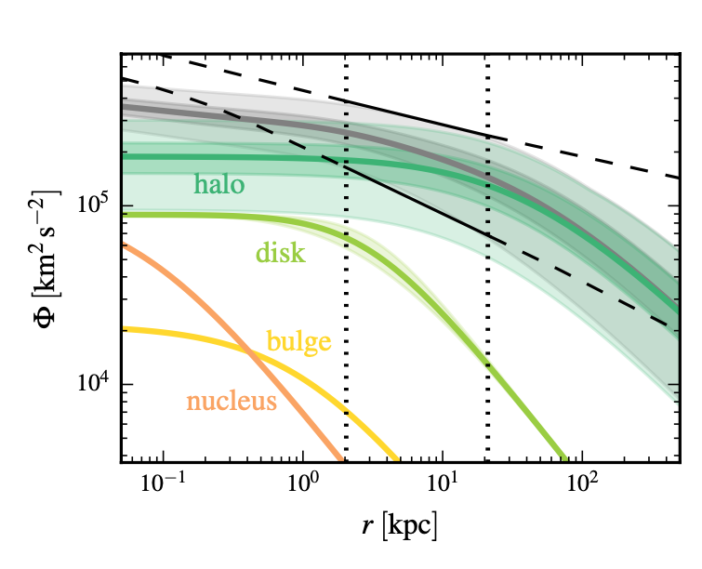Editor’s note: Astrobites is a graduate-student-run organization that digests astrophysical literature for undergraduate students. As part of the partnership between the AAS and astrobites, we occasionally repost astrobites content here at AAS Nova. We hope you enjoy this post from astrobites; the original can be viewed at astrobites.org.
Title: Evidence for an Intermediate-Mass Milky Way from Gaia DR2 Halo Globular Cluster Motions
Authors: Laura L. Watkins et al.
First Author’s Institution: University of Chicago
Status: Published in ApJ
We can’t put it on a digital scale, we can’t hang it on a balance and compare it against something else, so how does one measure the mass of our home galaxy? The authors of today’s paper use measurements of globular clusters in the halo of the galaxy taken from the Gaia satellite to estimate a mass for the Milky Way.
What Is Our Galaxy Made of and Why Should We Weigh It?
Our galaxy contains four major parts: the bulge, the disk (which contains the thin disk and the thick disk), the bar, and the halo (see Figure 1). The first three components are made up of baryons, particles that make up protons and neutrons and therefore most of the things around us. The halo, however, is dominated by dark matter, and the percentage of baryonic mass in the halo depends on how much dark matter there is. Dark matter is a mysterious substance that pervades the galaxy, interacting strongly with gravity and weakly with light. We know dark matter is there because of the rotation curve of the galaxy; if the mass was concentrated at the center, the velocity of the outer regions would be slower than the inner regions. In the case of the Milky Way, we see that the rotational velocity stays fairly constant all the way out, which points to some unseen matter being present (matter that we identify as dark matter). Because of its weak interactions with light, it can be really tough to measure the amount of dark matter, and thus how much it weighs. Overcoming this challenge to calculate a mass for the dark matter in our galaxy’s halo would be a big step in obtaining the mass of the Milky Way.
Measuring the mass of our galaxy is very useful for two reasons: first, because the mass of the galaxy and its distribution are linked to the formation and growth of our universe. Accurately determining the mass will help us understand where our galaxy sits on the scale of the cosmos. Second, it helps us learn about the dynamical history and future of the Local Group and the satellite population (specifically stellar streams).

Figure 1: Left: where the Sun sits in the Milky Way, from a face-on perspective. Right: The different parts of the galaxy, from an edge-on perspective. [ESA]
How to Weigh a Galaxy
The estimate of the mass of a galaxy is dependent on many things, including which satellites are bound and how long they have been that way, the shape of the Milky Way, and the method used for analysis. Three techniques have been mainly used to measure the mass of the galaxy: the timing argument, abundance-matching studies, and dynamical methods. The timing argument measures the speed at which two galaxies are approaching each other and uses those dynamics to predict a mass. Abundance-matching studies uses the number of galaxies versus their circular velocity and the Tully-Fischer relation to obtain their luminosity, which can be used to estimate their mass. Finally, dynamical methods look at the velocity of tracer objects such as globular clusters; any mass distribution gives rise to a gravitational potential that causes objects to move, so by studying the motions of the objects, we can work backwards to recover the gravitational potential, and thus the mass. The authors of today’s paper use this dynamical method to measure the mass of the Milky Way.
Using Gaia to Map Motions
The team used data from the Gaia mission’s 2nd data release (DR2) to measure the proper motions of stars, or how they are moving across the sky. Gaia is a space-based instrument whose goal is to make a 3D map of the galaxy, and this data release contained measurements for billions of stars and 75 globular clusters. Gaia’s observations are so precise that it can measure a human hair’s width at 1,000 km, which is a resolution 1,000–2,000 times higher than that of the Hubble Space Telescope! (Check out this really cool video on Gaia to learn more about this amazing satellite.) Figure 2 shows just how many sources Gaia has measured. Out of the 75 globular cluster measurements released in DR2, the authors used 34 of them that spanned a range of distances from 2.0 to 21.1 kiloparsecs from the center of the galaxy — which allowed the authors to trace the Milky Way’s mass out to the outer halo.

Figure 2: A map of the number of sources Gaia measures on a projection of the plane of the galaxy (centered on the galactic center). The lighter the color, the more sources. The two circles in the bottom right are two very small dwarf galaxies that orbit the Milky Way. This figure shows the billions of stars contained in DR2. [Brown et al. 2018]

Figure 3: The potential of the galaxy versus distance. Each component of the galaxy is labeled. The authors vary the virial radius and concentration (which represents the density) of the halo, and the different values they sample over are shown by the shaded region around the halo curve. The combination of the components (i.e., the total potential of the galaxy) is the gray line. The authors map the potential of the entire galaxy, but the vertical dotted lines show the area in which they’re interested, which is the distance of the nearest and farthest globular cluster in their sample. The solid lines show the extent of the best-fitting power law to that region, and the dashed lines show the power-law fit outside the region of interest. [Watkins et al. 2019]
Evidence for an Intermediate Mass Milky Way
The authors find that the mass of the galaxy is 0.21 x 1012 solar masses, the circular velocity of the galaxy at the maximum radius they look at (21.1 kpc) is 206 km/s, and the virial radius is 1.28 x 1012 solar masses. This virial mass fits in most with intermediate values found by other studies. The circular velocity measurement the authors made indicates that the velocity is fairly constant in the outer regions, supporting the idea that dark matter is present in our galaxy. Some of the clusters the team used for measurements are on very radial or very tangential orbits, which could have been the result of galactic collisions. If they remove these clusters, the mass and velocity measurements are still within their error bars, showing that these estimates are robust even if there are substructures of globular clusters in the galaxy.
The amazing wealth of data from the Gaia mission has allowed the team to make one of the most precise estimates of the mass of the galaxy that has ever been achieved. As Gaia continues its mission over the next few years, it will obtain positions and velocities of even more clusters, paving the way for more robust studies of the mass of our galaxy.
About the author, Haley Wahl:
I’m a third year grad student at West Virginia University and my main research area is pulsars. I’m currently working with the NANOGrav collaboration (a collaboration which is part of a worldwide effort to detect gravitational waves with pulsars) on polarization calibration. In my set of 45 millisecond pulsars, I’m looking at how the rotation measure (how much the light from the star is rotated by the interstellar medium on its way to us) changes over time, which can tell us about the variation of the galactic magnetic field. I’m mainly interested in pulsar emission and the weird things we see pulsars do! In addition to doing research, I’m also a huge fan of running, baking, reading, watching movies, and I LOVE dogs!


2 Comments
Pingback: From astrobites: “How Do You Weigh a Galaxy?” | sciencesprings
Pingback: Our Galaxy is Shook: Impact of the LMC on the Outer Milky Way | astrobites